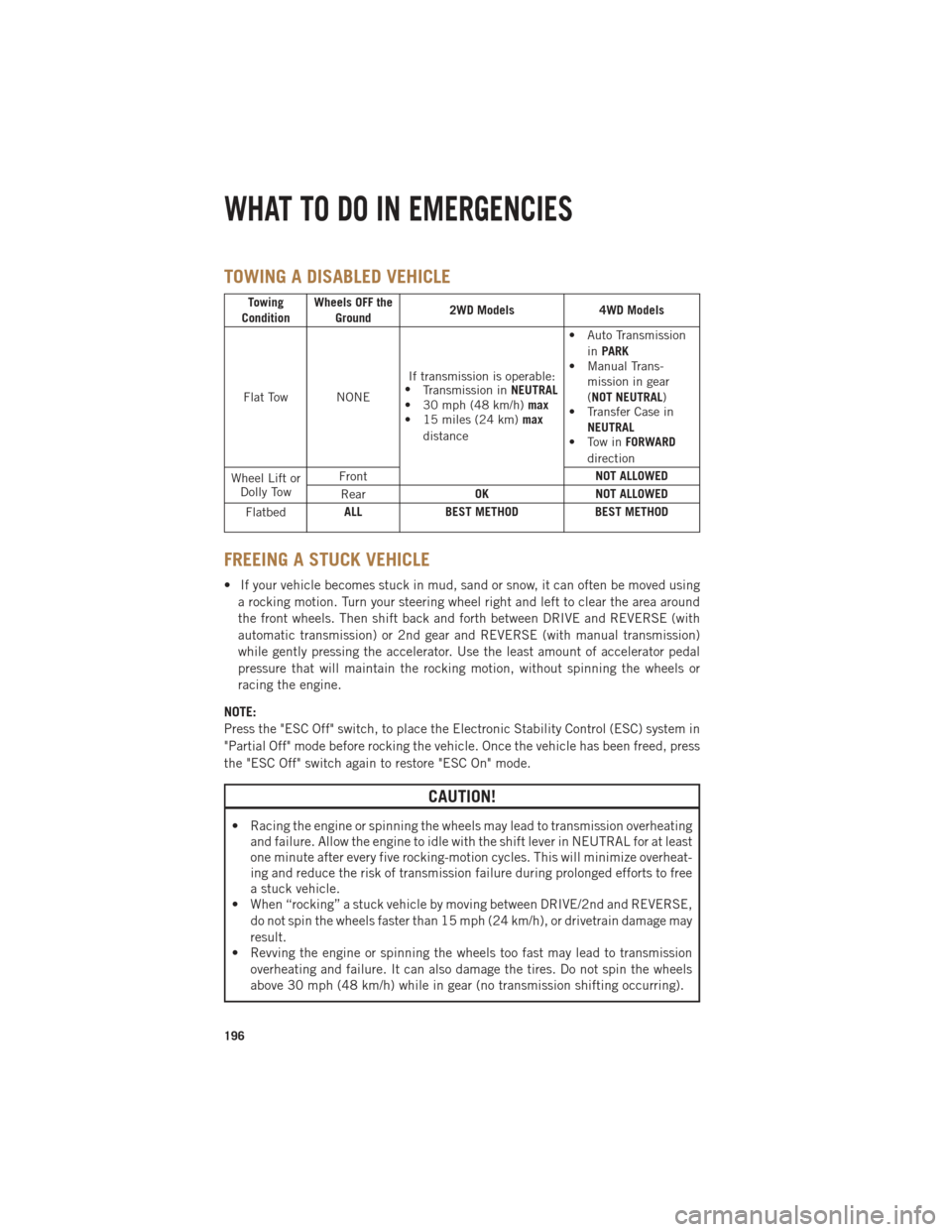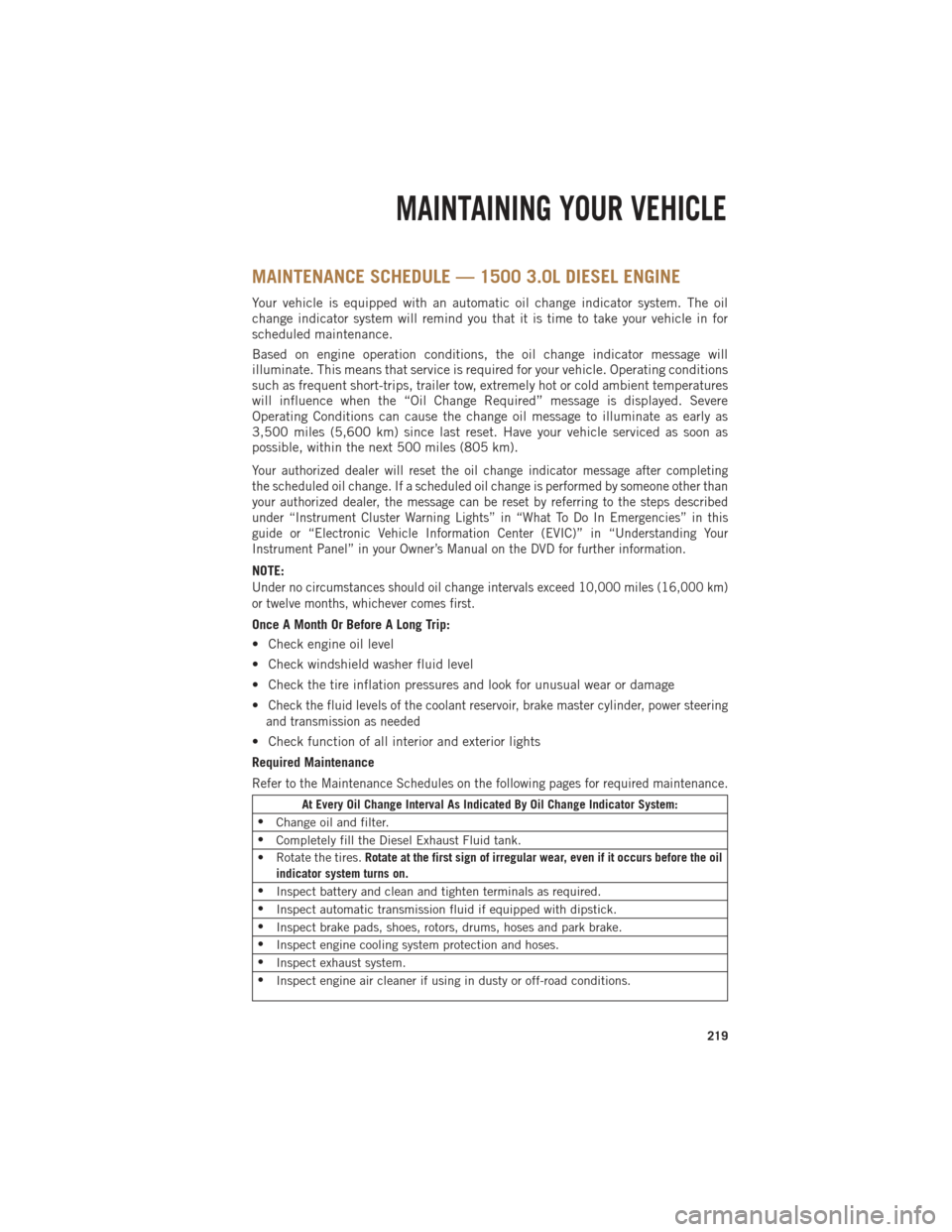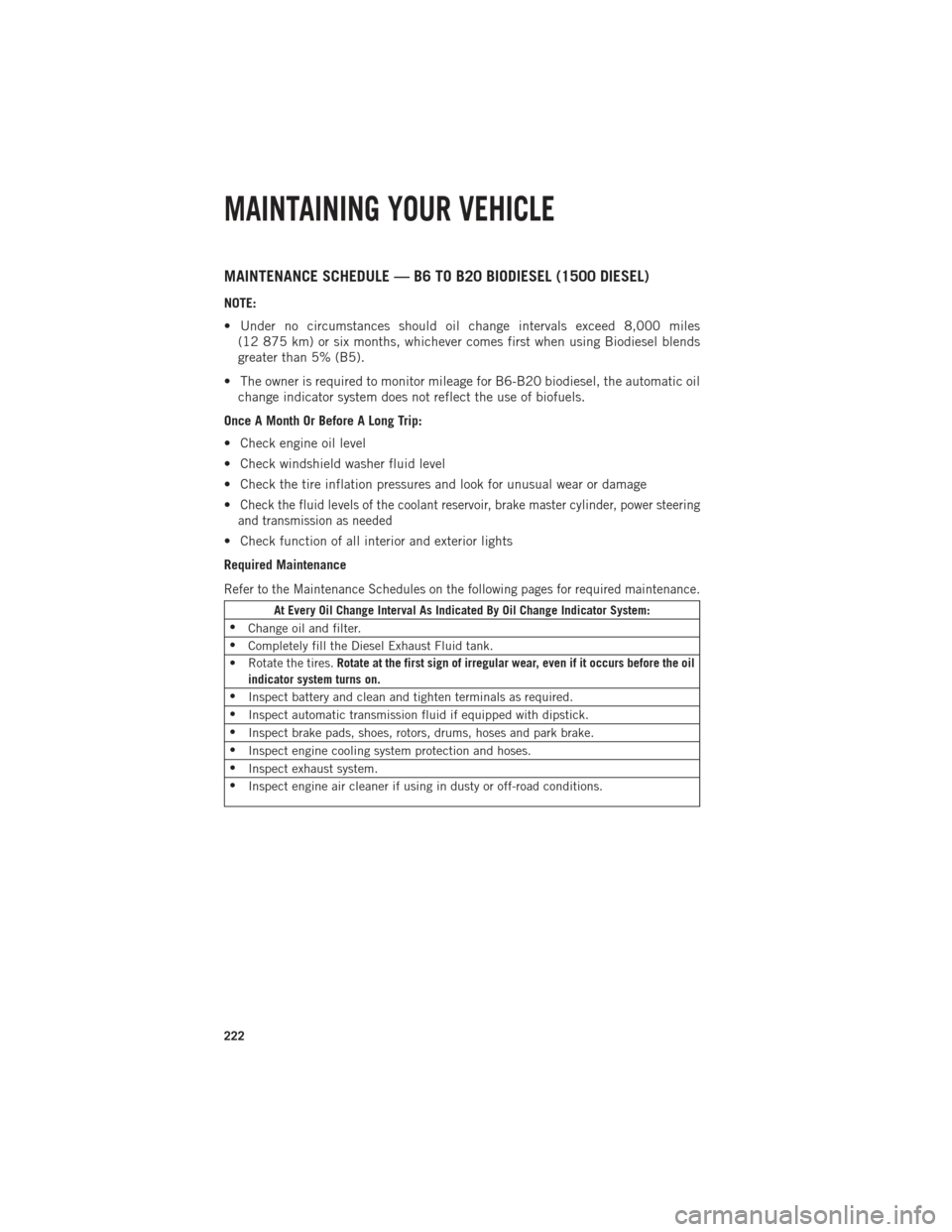flat tire Ram 1500 2014 Get to Know Guide
[x] Cancel search | Manufacturer: RAM, Model Year: 2014, Model line: 1500, Model: Ram 1500 2014Pages: 252, PDF Size: 6.74 MB
Page 191 of 252

WARNING!
•Do not attempt to change a tire on the side of the vehicle close to moving traffic.
Pull far enough off the road to avoid the danger of being hit when operating the
jack or changing the wheel.
•Being under a jacked-up vehicle is dangerous. The vehicle could slip off the jack
and fall on you. You could be crushed. Never put any part of your body under a
vehicle that is on a jack.
•Never start or run the engine while the vehicle is on a jack. If you need to get under
a raised vehicle, take it to an authorized dealer where it can be raised on a lift.
• The jack is designed to be used as a tool for changing tires only. The jackshould not be used to lift the vehicle for service purposes. The vehicle should
be jacked on a firm level surface only. Avoid ice or slippery areas.
•
Do not attempt to change a tire on the side of the vehicle close to moving traffic,
pull far enough off the road to avoid the danger of being hit when operating the
jack or changing the wheel.
• Carefully follow these tire changing warnings to help prevent personal injury or
damage to your vehicle:
• Always park on a firm, level surface as far from the edge of the roadwayas possible before raising the vehicle.
• Turn on the Hazard Warning flashers.
• Block the wheel diagonally opposite the wheel to be raised.
• Set the parking brake firmly and set an automatic transmission in PARK;
a manual transmission in REVERSE.
• Do not let anyone sit in the vehicle when it is on a jack.
• Do not get under the vehicle when it is on a jack.
• Only use the jack in the positions indicated and for lifting this vehicle
during a tire change.
• If working on or near a roadway, be extremely careful of motor traffic.
• To assure that spare tires, flat or inflated, are securely stowed, spares
must be stowed with the valve stem facing the ground.
•
Raising the vehicle higher than necessary can make the vehicle less stable.
It could slip off the jack and hurt someone near it. Raise the vehicle only
enough to remove the tire.
• To avoid the risk of forcing the vehicle off the jack, do not fully tighten
the wheel bolts until the vehicle has been lowered. Failure to follow this
warning may result in personal injury.
• To avoid possible personal injury, handle the wheel covers with care to
avoid contact with any sharp edges.
•
A loose tire or jack thrown forward in a collision or hard stop could endan-
ger the occupants of the vehicle. Always stow the jack parts and the spare
tire in the places provided.
•A loose tire thrown forward in a collision or hard stop could injure the
occupants in the vehicle. Have the deflated (flat) tire repaired or replaced
immediately.
WHAT TO DO IN EMERGENCIES
189
Page 198 of 252

TOWING A DISABLED VEHICLE
Towing
Condition Wheels OFF the
Ground 2WD Models
4WD Models
Flat Tow NONE If transmission is operable:
• Transmission in NEUTRAL
• 30 mph (48 km/h) max
• 15 miles (24 km) max
distance • Auto Transmission
inPARK
• Manual Trans-
mission in gear
(NOT NEUTRAL)
• Transfer Case in
NEUTRAL
• Tow in FORWARD
direction
Wheel Lift or Dolly Tow Front
NOT ALLOWED
Rear OK
NOT ALLOWED
Flatbed ALL
BEST METHOD BEST METHOD
FREEING A STUCK VEHICLE
• If your vehicle becomes stuck in mud, sand or snow, it can often be moved using
a rocking motion. Turn your steering wheel right and left to clear the area around
the front wheels. Then shift back and forth between DRIVE and REVERSE (with
automatic transmission) or 2nd gear and REVERSE (with manual transmission)
while gently pressing the accelerator. Use the least amount of accelerator pedal
pressure that will maintain the rocking motion, without spinning the wheels or
racing the engine.
NOTE:
Press the "ESC Off" switch, to place the Electronic Stability Control (ESC) system in
"Partial Off" mode before rocking the vehicle. Once the vehicle has been freed, press
the "ESC Off" switch again to restore "ESC On" mode.
CAUTION!
• Racing the engine or spinning the wheels may lead to transmission overheating and failure. Allow the engine to idle with the shift lever in NEUTRAL for at least
one minute after every five rocking-motion cycles. This will minimize overheat-
ing and reduce the risk of transmission failure during prolonged efforts to free
a stuck vehicle.
• When “rocking” a stuck vehicle by moving between DRIVE/2nd and REVERSE,
do not spin the wheels faster than 15 mph (24 km/h), or drivetrain damage may
result.
• Revving the engine or spinning the wheels too fast may lead to transmission
overheating and failure. It can also damage the tires. Do not spin the wheels
above 30 mph (48 km/h) while in gear (no transmission shifting occurring).
WHAT TO DO IN EMERGENCIES
196
Page 221 of 252

MAINTENANCE SCHEDULE — 1500 3.0L DIESEL ENGINE
Your vehicle is equipped with an automatic oil change indicator system. The oil
change indicator system will remind you that it is time to take your vehicle in for
scheduled maintenance.
Based on engine operation conditions, the oil change indicator message will
illuminate. This means that service is required for your vehicle. Operating conditions
such as frequent short-trips, trailer tow, extremely hot or cold ambient temperatures
will influence when the “Oil Change Required” message is displayed. Severe
Operating Conditions can cause the change oil message to illuminate as early as
3,500 miles (5,600 km) since last reset. Have your vehicle serviced as soon as
possible, within the next 500 miles (805 km).
Your authorized dealer will reset the oil change indicator message after completing
the scheduled oil change. If a scheduled oil change is performed by someone other than
your authorized dealer, the message can be reset by referring to the steps described
under “Instrument Cluster Warning Lights” in “What To Do In Emergencies” in this
guide or “Electronic Vehicle Information Center (EVIC)” in “Understanding Your
Instrument Panel” in your Owner’s Manual on the DVD for further information.
NOTE:
Under no circumstances should oil change intervals exceed 10,000 miles (16,000 km)
or twelve months, whichever comes first.
Once A Month Or Before A Long Trip:
• Check engine oil level
• Check windshield washer fluid level
• Check the tire inflation pressures and look for unusual wear or damage
•
Check the fluid levels of the coolant reservoir, brake master cylinder, power steering
and transmission as needed
• Check function of all interior and exterior lights
Required Maintenance
Refer to the Maintenance Schedules on the following pages for required maintenance.
At Every Oil Change Interval As Indicated By Oil Change Indicator System:
• Change oil and filter.
• Completely fill the Diesel Exhaust Fluid tank.
• Rotate the tires. Rotate at the first sign of irregular wear, even if it occurs before the oil
indicator system turns on.
• Inspect battery and clean and tighten terminals as required.
• Inspect automatic transmission fluid if equipped with dipstick.
• Inspect brake pads, shoes, rotors, drums, hoses and park brake.
• Inspect engine cooling system protection and hoses.
• Inspect exhaust system.
• Inspect engine air cleaner if using in dusty or off-road conditions.
MAINTAINING YOUR VEHICLE
219
Page 224 of 252

MAINTENANCE SCHEDULE — B6 TO B20 BIODIESEL (1500 DIESEL)
NOTE:
• Under no circumstances should oil change intervals exceed 8,000 miles(12 875 km) or six months, whichever comes first when using Biodiesel blends
greater than 5% (B5).
• The owner is required to monitor mileage for B6-B20 biodiesel, the automatic oil change indicator system does not reflect the use of biofuels.
Once A Month Or Before A Long Trip:
• Check engine oil level
• Check windshield washer fluid level
• Check the tire inflation pressures and look for unusual wear or damage
•
Check the fluid levels of the coolant reservoir, brake master cylinder, power steering
and transmission as needed
• Check function of all interior and exterior lights
Required Maintenance
Refer to the Maintenance Schedules on the following pages for required maintenance.
At Every Oil Change Interval As Indicated By Oil Change Indicator System:
• Change oil and filter.
• Completely fill the Diesel Exhaust Fluid tank.
• Rotate the tires. Rotate at the first sign of irregular wear, even if it occurs before the oil
indicator system turns on.
• Inspect battery and clean and tighten terminals as required.
• Inspect automatic transmission fluid if equipped with dipstick.
• Inspect brake pads, shoes, rotors, drums, hoses and park brake.
• Inspect engine cooling system protection and hoses.
• Inspect exhaust system.
• Inspect engine air cleaner if using in dusty or off-road conditions.
MAINTAINING YOUR VEHICLE
222
Page 236 of 252

TIRE PRESSURES
Check the inflation pressure of each tire, including the spare tire, at least monthly
and inflate to the recommended pressure for your vehicle.
The tire pressures recommended for your vehicle are found on the “Tire and Loading
Information” label located on the driver’s side door opening.
NOTE:
Refer to the Owner's Manual on the DVD
for more information regarding tire warn-
ings and instructions.
WARNING!
•Overloading of your tires is dangerous. Overloading can cause tire failure, affect
vehicle handling, and increase your stopping distance. Use tires of the recom-
mended load capacity for your vehicle. Never overload them.
•Improperly inflated tires are dangerous and can cause collisions. Under-inflation
is the leading cause of tire failure and may result in severe cracking, component
separation, or “blow out”. Over-inflation reduces a tire’s ability to cushion shock.
Objects on the road and chuck holes can cause damage that results in tire failure.
Unequal tire pressures can cause steering problems. You could lose control of
your vehicle. Over-inflated or under-inflated tires can affect vehicle handling and
can fail suddenly, resulting in loss of vehicle control.
WHEEL AND WHEEL TRIM CARE
All wheels and wheel trim, especially aluminum and chrome plated wheels, should
be cleaned regularly with a mild soap and water to prevent corrosion.
To remove heavy soil and/or excessive brake dust, use MOPAR
®Wheel Cleaner or
equivalent or select a non-abrasive, non-acidic cleaner.
Tire And Loading Information Location (Example)
MAINTAINING YOUR VEHICLE
234
Page 242 of 252

OFF-ROAD CAPABILITIES
How do I shift into different four-wheel drive selections? pg. 126
UTILITY
How do I know how much I can tow with my Ram Truck? pg. 136
How do I adjust the gain on the Integrated Trailer Brake Module? pg. 138
WHAT TO DO IN EMERGENCIES
How do I change a flat tire? pg. 178
How do I Jump-Start my vehicle? pg. 190
MAINTAINING YOUR VEHICLE
Where is my Fuse Block located? pg. 230
What type of oil do I use? pg. 205
How often should I change my engine’s oil?
• Gasoline Engine pg. 214
• Cummins
®Diesel Engine pg. 225
• 1500 Diesel Engine pg. 219
FREQUENTLY ASKED QUESTIONS
240
Page 244 of 252

Emergency, In Case ofFreeing Vehicle When Stuck . .196
Overheating ............175
Towing ........... 169, 196
Engine Block Heater ...........155
Break-In
Recommendations . .32, 145, 155
Compartment ...........199
Malfunction Indicator
(CheckEngine) ..........172
OilSelection ...........205
Overheating ............175
Starting ...............13
Stopping ..............13
Event Data Recorder .........197
Exhaust Brake .............157
Exhaust Regeneration ........148
Exterior Lights .............235
Filters EngineFuel ........ 147, 158
FlatTireStowage...........188
Fluid Capacities ............205
Fluids .................205
FogLights................34
Freeing A Stuck Vehicle .......196
Front And Rear ParkSense System...46
Front Heated Seats ...........27
Front ParkSense System ........46
Fuel Specifications ..........205
Fuse ..................230
Fuses..................230
Garage Door Opener (HomeLink
®)............120
Headlight ................34
Headlights Automatic .............34
Dimmer Switch ..........34
HighBeam .............33
Switch ...............34 Head Restraints
............24
Heated Seats ..............27
Heated Steering Wheel ........30
Heater, Engine Block .........155
High Beam/Low Beam Select (Dimmer) Switch ..........33
HomeLink
®
(Garage Door Opener) .......120
Hood Release .............198
HubCaps ...............186
Idle Up Feature ............158
Integrated Trailer Brake Controls . .138
Interior and Instrument Lights . . .7, 51
Intermittent Wipers (Delay Wipers) ............33
Introduction ...............3
Inverter Outlet (115V) ........123
Inverter, Power ............123
Jack Location .............176
Jump Starting .............190
KeyFob.................10 Arm The Alarm ...........14
Disarm The Alarm .........14
Keyless Enter-N-Go ...........12
Lock/Unlock ............12
Starting/Stopping .........13
LaneChangeandTurnSignals....33
Lane Change Assist ..........33
LATCH (Lower Anchors and TetherforCHildren)....17,18,19
Lights
Engine Temperature Warning. .170
TurnSignal .............33
Maintenance Record. . .218, 224, 229
Maintenance Schedule.... 214, 219, 225, 227
Malfunction Indicator Light(CheckEngine).......172
MemorySeat ..............26
INDEX
242
Page 246 of 252

Spark Plugs..............205
Speed Control Accel/Decel ............36
Speed Control (Cruise Control) ....35
Starting ColdWeather ........ 146, 156
Remote ...............13
Starting Procedures (Diesel Engines) .......145, 155
Stuck, Freeing .............196
SunRoof ................48
Tailgate ................129
Temperature Control, Automatic (ATC).................45
Tether Anchor, Child Restraint ....18
Tires Air Pressure ...........234
Changing .............178
FlatChanging ..........178
Jacking ..............178
Pressure Warning Light .....169
Tow/Haul ................138
Tow Hooks, Emergency ........192
Towing Disabled Vehicle .........196
Recreational ...........140
Towing Vehicle Behind a Motorhome.............140
Traction Control ............172 Trailer Towing
Trailer and Tongue Weight . . .136
Transfer Case Fluid ................205
Transmission Fluid ................205
Warning Light ..........174
TurboCoolDown........ 149, 162
TurnSignals...............33
Uconnect
®3.0.............67
Uconnect®5.0.............70
Uconnect®8.4A ............78
Uconnect®8.4AN ...........96
Uconnect®Access ...........53
Vehicle Security Alarm Disarming . .14
Ventilated Seats ............28
Washers, Windshield ..........33
Water in Fuel . . .146, 147, 156, 158
Water Separator, Diesel Fuel .......... 147, 158
Water Separator Draining . . .147, 158
WheelandWheelTrimCare.....234
Wheel Cover ..............186
WheelNutTorque...........186
Wind Buffeting .............49
WindshieldWashers ..........33
WindshieldWipers...........33
INDEX
244